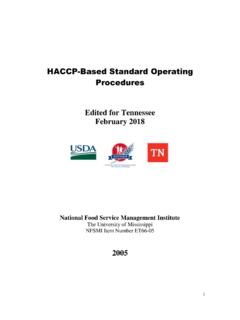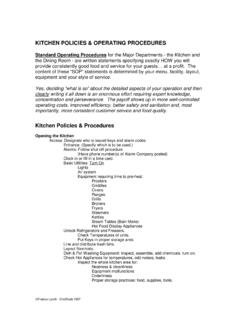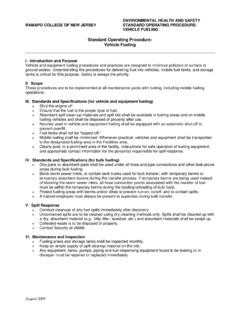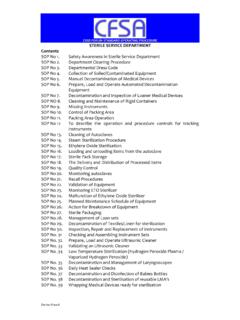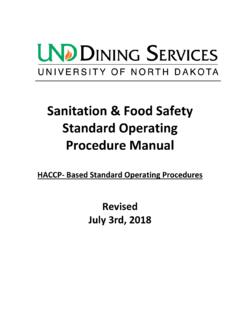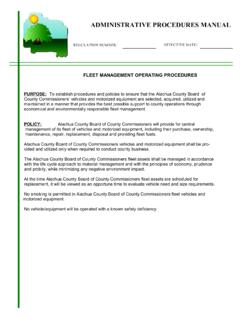Transcription of Operating Procedure
1 LSASDPROC-300-R4 Soil Sampling Effective Date: June 11, 2020 _____ Page 1 of 29 Purpose This document describes general and specific procedures , methods and considerations to be used and observed when collecting soil samples for field screening or laboratory analysis. Scope/Application The procedures contained in this document are to be used by field personnel when collecting and handling soil samples in the field. On the occasion that LSASD field personnel determine that any of the procedures described in this section are inappropriate, inadequate or impractical and that another Procedure must be used to obtain a soil sample, the variant Procedure will be documented in the field logbook and subsequent investigation report, along with a description of the circumstances requiring its use. Mention of trade names or commercial products in this Operating Procedure does not constitute endorsement or recommendation for use.
2 Region 4 Environmental Protection Agency Laboratory Services and Applied Science Division Athens, Georgia Operating Procedure Title: Soil Sampling ID: LSASDPROC-300-R4 Issuing Authority: LSASD Field Branch Chief Effective Date: June 11, 2020 Review Due Date: June 11, 2024 Uncontrolled When PrintedLSASDPROC-300-R4 Soil Sampling Effective Date: June 11, 2020 _____ Page 2 of 29 Table of Contents Purpose .. 1 Scope/Application .. 1 1 General Information .. 4 Documentation/Verification .. 4 General Precautions .. 4 Safety .. 4 Procedural 4 2 Special Sampling Considerations .. 5 Special Precautions for Trace Contaminant Soil Sampling .. 5 Sample Homogenization .. 6 Dressing Soil Surfaces .. 6 Quality Control .. 7 Records .. 7 3 Samples Collected for Volatile Organic Compounds (VOC) or for Per- and Polyfluoroalkyl Substances (PFAS) Analyses .. 7 Soil Samples Collected for Volatile Organic Compounds (VOC) Analysis.
3 7 Soil Sampling for VOCs (Method 5035) .. 7 Equipment .. 8 Sampling Methodology - Low Concentrations (<200 g/kg) .. 8 Sampling Methodology - High Concentrations (>200 g/kg) .. 9 Special Techniques and Considerations for Method 5035 .. 9 Table 1: Method 5035 Summary .. 12 Soil Samples for Per- and Polyfluoroalkyl Substances (PFAS) Analysis .. 13 Sampling Equipment .. 13 PFAS Soil Sample Mixing and Homogenization Considerations .. 13 Trace Level Sampling Technique for PFAS .. 13 Quality Control Samples and Standard Operating procedures .. 14 4 Manual Soil Sampling 15 General .. 15 Spoons .. 15 Special Considerations When Using Spoons .. 15 Hand Augers .. 15 Surface Soil 16 Subsurface Soil Sampling .. 16 Special Considerations for Soil Sampling with the Hand Auger .. 16 5 Direct Push Soil Sampling Methods .. 17 General .. 17 Large Bore Soil Sampler .. 17 Macro-Core Soil Sampler .. 17 Dual Tube Soil Sampling System.
4 18 Special Considerations When Using Direct Push Sampling Methods .. 18 6 Split Spoon/Drill Rig Methods .. 19 General .. 19 Standard Split 20 Continuous Split Spoon .. 20 Uncontrolled When PrintedLSASDPROC-300-R4 Soil Sampling Effective Date: June 11, 2020 _____ Page 3 of 29 Special Considerations When Using Split Spoon Sampling Methods .. 20 7 Shelby Tube/Thin-Walled Sampling Methods .. 21 General .. 21 Shelby Tube Sampling Method .. 21 Special Considerations When Using Split Spoon Sampling Methods .. 21 8 Backhoe Sampling Method .. 22 General .. 22 Scoop-and-Bracket Method .. 22 Direct-from-Bucket Method .. 22 Special Considerations When Sampling with a Backhoe .. 22 9 Incremental Sampling Method .. 23 General .. 23 Field Implementation, Sample Collection, and Processing .. 23 Introduction .. 23 Sampling Tools .. 24 Field Collection .. 24 Field Handling of ISM Samples .. 24 Special Considerations When Using Incremental Sampling Methods.
5 25 Figure 1 .. 26 Figure 2 .. 26 10 References .. 27 11 Revision History .. 28 Uncontrolled When PrintedLSASDPROC-300-R4 Soil Sampling Effective Date: June 11, 2020 _____ Page 4 of 29 1 General Information Documentation/Verification This Procedure was prepared by persons deemed technically competent by LSASD management, based on their knowledge, skills and abilities and have been tested in practice and reviewed in print by a subject matter expert. The official copy of this Procedure resides on the LSASD local area network (LAN). The QAC is responsible for ensuring the most recent version of the Procedure is placed on the LAN, and for maintaining records of review conducted prior to its issuance. General Precautions Safety Proper safety precautions must be observed when collecting soil samples. Refer to the LSASD Safety and Occupational Health Manual and any pertinent site-specific Health and Safety Plans (HASP) and Job Hazard Assessments for guidelines on safety precautions.
6 These guidelines, however, should only be used to complement the judgment of an experienced professional. The reader should address chemicals that pose specific toxicity or safety concerns and follow any other relevant requirements, as appropriate. Procedural Precautions The following precautions should be considered when collecting soil samples: Special care must be taken not to contaminate samples. This includes storing samples in a secure location to preclude conditions which could alter the properties of the sample. Samples shall be custody sealed during long-term storage or shipment. Collected samples are in the custody of the sampler or sample custodian until the samples are relinquished to another party. If samples are transported by the sampler, they will remain under his/her custody or be secured until they are relinquished. Shipped samples shall conform to all Department of Transportation (DOT) rules of shipment found in Title 49 of the Code of Federal Regulations (49 CFR parts 171 to 179), and/or International Air Transportation Association (IATA) hazardous materials shipping requirements found in the current edition of IATA s Dangerous Goods Regulations.
7 Documentation of field sampling is done in a bound logbook. Uncontrolled When PrintedLSASDPROC-300-R4 Soil Sampling Effective Date: June 11, 2020 _____ Page 5 of 29 Chain-of-custody documents shall be filled out and remain with the samples until custody is relinquished. All shipping documents, such as air bills, bills of lading, etc., shall be retained by the project leader in the project files. (Air bills are generated online via UPS Campusship program and package tracking is done online). Receipts are not always received at time of shipping. Sampling in landscaped areas: Cuttings should be placed on plastic sheeting and returned to the borehole upon completion of the sample collection. Any turf plug generated during the sampling process should be returned to the borehole. Sampling in non-landscaped areas: Return any unused sample material back to the auger, drill or push hole from which the sample was collected. 2 Special Sampling Considerations Special Precautions for Trace Contaminant Soil Sampling A clean pair of new, non-powdered, disposable gloves will be worn each time a different sample is collected and the gloves should be donned immediately prior to sampling.
8 The gloves should not come in contact with the media being sampled and should be changed any time during sample collection when their cleanliness is compromised. Sample containers with samples suspected of containing high concentrations of contaminants shall be handled and stored separately. All background samples shall be segregated from obvious high-concentration or waste samples. Sample collection activities shall proceed progressively from the least suspected contaminated area to the most suspected contaminated area. Samples of waste or highly-contaminated media must not be placed in the same ice chest as environmental ( , containing low contaminant levels) or background samples. If possible, one member of the field sampling team should take all the notes and photographs, fill out tags, etc., while the other member(s) collect the samples. Samplers must use new, verified/certified-clean disposable or non-disposable equipment cleaned according to procedures contained in the LSASD Operating Procedure for Field Equipment Cleaning and Decontamination (SESDPROC-205), for collection of samples for trace metals or organic compound analyses.
9 Uncontrolled When PrintedLSASDPROC-300-R4 Soil Sampling Effective Date: June 11, 2020 _____ Page 6 of 29 Sample Homogenization 1. If sub-sampling of the primary sample is to be performed in the laboratory, transfer the entire primary sample directly into an appropriate, labeled sample container(s). Proceed to step 4. 2. If sub-sampling the primary sample in the field or compositing multiple primary samples in the field, place the sample into a glass or stainless steel homogenization container and mix thoroughly. Each aliquot of a composite sample should be of the same approximate volume. 3. All soil samples must be thoroughly mixed to ensure that the sample is as representative as possible of the sample media. Samples for VOC analysis are not homogenized. The most common method of mixing is referred to as quartering. The quartering Procedure should be performed as follows: The material in the sample pan should be divided into quarters and each quarter should be mixed individually.
10 Two quarters should then be mixed to form halves. The two halves should be mixed to form a homogenous matrix. This Procedure should be repeated several times until the sample is adequately mixed. If round bowls are used for sample mixing, adequate mixing is achieved by stirring the material in a circular fashion, reversing direction, and occasionally turning the material over. 4. Place the sample into an appropriate, labeled container(s) by using the alternate shoveling method and secure the cap(s) tightly. The alternate shoveling method involves placing a spoonful of soil in each container in sequence and repeating until the containers are full or the sample volume has been exhausted. Threads on the container and lid should be cleaned to ensure a tight seal when closed. Dressing Soil Surfaces Any time a vertical or near vertical surface is sampled, such as achieved when shovels or similar devices are used for subsurface sampling, the surface should be dressed (scraped) to remove smeared soil.










